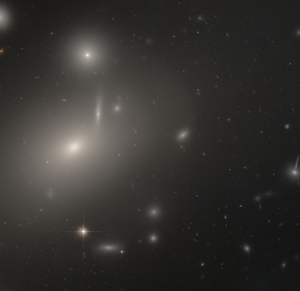NGC 4889
| Galaxie NGC 4889/NGC 4884 | |
|---|---|
 | |
| Die elliptische Galaxie NGC 4889 (links) aufgenommen von dem Hubble-Weltraumteleskop | |
| AladinLite | |
| Sternbild | Haar der Berenike |
| Position Äquinoktium: J2000.0, Epoche: J2000.0 | |
| Rektaszension | 13h 00m 08,1s[1] |
| Deklination | +27° 58′ 37″[1] |
| Erscheinungsbild | |
| Morphologischer Typ | cD;E4;Dd/PAS[1] |
| Helligkeit (visuell) | 11,5 mag[2] |
| Helligkeit (B-Band) | 12,5 mag[2] |
| Winkelausdehnung | 2,8′ × 2′[2] |
| Positionswinkel | 80°[2] |
| Flächenhelligkeit | 13,4 mag/arcmin²[2] |
| Physikalische Daten | |
| Zugehörigkeit | Coma-Haufen Abell 1656[1] |
| Rotverschiebung | 0.021502 ± 0.000010[1] |
| Radialgeschwindigkeit | (6446 ± 3) km/s[1] |
| Hubbledistanz H0 = 73 km/(s • Mpc) | (289 ± 20) · 106 Lj (88,5 ± 6,2) Mpc [1] |
| Durchmesser | 235.000 Lj[3] |
| Geschichte | |
| Entdeckung | Wilhelm Herschel |
| Entdeckungsdatum | 11. April 1785 |
| Katalogbezeichnungen | |
| NGC 4889/4884 • UGC 8110 • PGC 44715 • CGCG 160-241 • MCG +05-31-077 • 2MASX J13000809+2758372 • GC 3351 • H II 391 • h 1507 • LDCE 0926 NED051 | |
NGC 4889 ist eine sehr große elliptische Galaxie im Sternbild Haar der Berenike, die fast im Zentrum des Coma-Haufens liegt und etwa 289 Millionen Lichtjahre von der Milchstraße entfernt ist.
Sie ist vom Typus der cD-Galaxien und dominiert – zusammen mit einer zweiten, etwas schwächer leuchtenden Riesengalaxie namens NGC 4874 – das Schwerefeld des Galaxienhaufens. Die beiden Sternsysteme haben ein hohes Alter und sind wahrscheinlich aus der Verschmelzung mehrerer kleiner Spiralgalaxien entstanden.
NGC 4889 wurde am 11. April 1785 von dem deutsch-britischen Astronomen Wilhelm Herschel entdeckt. 1973 erklärten Jack Sulentic und William Tifft im RNGC die von Heinrich Ludwig d’Arrest am 6. April 1864 beschriebene Galaxie NGC 4884 als identisch mit NGC 4889.[4]
Im Zentrum von NGC 4889 befindet sich das größte bisher (Stand Dezember 2019) direkt gemessene schwarze Loch, mit einer Masse von geschätzten 21 Milliarden Sonnenmassen (‚best fit‘ aus dem Bereich 6 bis 37 Milliarden Sonnenmassen).[5]
Weblinks
Einzelnachweise
Auf dieser Seite verwendete Medien
Autor/Urheber: Roberto Mura, Lizenz: CC BY-SA 3.0
Caldwell Catalogue objects.
Autor/Urheber: Judy Schmidt from Fresh Meadows, NY, USA, Lizenz: CC BY 2.0
A dominant member of the Coma Cluster, remarkable elliptical shell galaxy NGC 4889 looms large over its domain. Within the cluster, only NGC 4874 (not shown) is brighter, and only just barely.
The faintly visible shells of the galaxy are evidence that the monstrous galaxy recently merged with a smaller galaxy.
Other details to notice include smaller and/or more distant elliptical galaxies, some of which are ghostly and faint. I have seen them called them fluffy galaxies in this recent press release. The nature of these ultra-diffuse galaxies and specifically how they manage to form as they do is still a matter of speculation.
Very few Milky Way stars are visible within the field. As usual, the ones with four spikes are most likely foreground stars. The hundreds of tiny, fainter point-like objects are globular clusters, many of which are likely orbiting NGC 4889.
Do you think that maybe some background galaxies show a curious alignment? You might not be imagining it. It's possible that some weak gravitational lensing is going on. Weak gravitational lensing is detectable by taking measurements of all the background galaxies and seeing if they all seem a bit squished in a certain direction.
One final curiosity that I would like to note about NGC 4889: If you measure the brightness of the center of its nucleus, it is actually not as bright as NGC 4886, which is the smaller elliptical galaxy just above it in this image (that one skinny galaxy is kind of pointing toward it). The way some elliptical galaxies have diffuse cores while others have very sharp ones is something that perplexes me. It seems that even though NGC 4889 is much larger than NGC 4886, its nucleus is notably less dense than NGC 4886's.
Red: ACS / WFC F814W (jb2i02020_drc) Green: Pseudo Blue: ACS / WFC F475W (jb2i02010_drc & jb2i03010_drc)
North is NOT up. It is 43.6° counter-clockwise from up.

